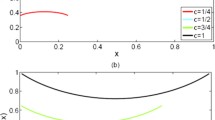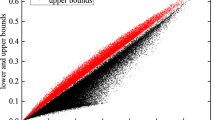Abstract
It is well known that entanglement of formation (EOF) and relative entropy of entanglement (REE) are exactly identical for all two-qubit pure states even though their definitions are completely different. We think this fact implies that there is a veiled connection between EOF and REE. In this context, we suggest a procedure, which enables us to compute REE from EOF without relying on the converse procedure. It is shown that the procedure yields correct REE for many symmetric mixed states such as Bell-diagonal, generalized Vedral–Plenino, and generalized Horodecki states. It also gives a correct REE for less symmetric Vedral–Plenio-type state. However, it is shown that the procedure does not provide correct REE for arbitrary mixed states.

Similar content being viewed by others
Notes
Since REE is defined through another separable state \(\sigma \), it is called “distance entanglement measure”. Another example of the distance entanglement measure is a geometric entanglement measure defined as \(E_g (\psi )= 1-P_{\mathrm{max}}\), where \(P_{\mathrm{max}}\) is a maximal overlap of a given state \(|\psi \rangle \) with the nearest product state [4–6].
If \(\lambda _3 \le 1/2\), \(\rho _{\mathrm{BD}}\) is a separable state.
If \(\lambda _1 \le 2 \sqrt{\lambda _2 \lambda _3}\), \(\rho _{H}\) becomes a separable state.
References
Bennett, C.H., DiVincenzo, D.P., Smokin, J.A., Wootters, W.K.: Mixed-state entanglement and quantum error correction. Phys. Rev. A 54, 3824 (1996). [ quant-ph/9604024]
Vedral, V., Plenio, M.B., Rippin, M.A., Knight, P.L.: Quantifying entanglement. Phys. Rev. Lett. 78, 2275 (1997). [ quant-ph/9702027]
Vedral, V., Plenio, M.B.: Entanglement measures and purification procedures. Phys. Rev. A 57, 1619 (1998). [ quant-ph/9707035]
Shimony, A.: Degree of entanglement. In: Greenberg, D.M., Zeilinger, A. (eds.) Fundamental problems in quantum theory: a conference held in honor of J. A. Wheeler. Ann. N. Y. Acad. Sci. 755, 675 (1995)
Barnum, H., Linden, N.: Monotones and invariants for multi-particle quantum states. J. Phys. A: Math. Gen. 34, 6787 (2001). [ quant-ph/0103155]
Wei, T.-C., Goldbart, P.M.: Geometric measure of entanglement and application to bipartite and multipartite quantum states. Phys. Rev. A 68, 042307 (2003). [ quant-ph/0307219]
Uhlmann, A.: Fidelity and concurrence of conjugate states. Phys. Rev. A 62, 032307 (2000). [ quant-ph/9909060]
Hill, S., Wootters, W.K.: Entanglement of a pair of quantum bits. Phys. Rev. Lett. 78, 5022 (1997). [ quant-ph/9703041]
Wootters, W.K.: Entanglement of formation of an arbitrary state of two qubits. Phys. Rev. Lett. 80, 2245 (1998). [ quant-ph/9709029]
Coffman, V., Kundu, J., Wootters, W.K.: Distributed entanglement. Phys. Rev. A 61, 052306 (2000). [ quant-ph/9907047]
Osterloh, A., Siewert, J.: Constructing \(N\)-qubit entanglement monotones from antilinear operators. Phys. Rev. A 72, 012337 (2005). [ quant-ph/0410102]
Doković, D.Ž., Osterloh, A.: On polynomial invariants of several qubits. J. Math. Phys. 50, 033509 (2009). [ arXiv:0804.1661 (quant-ph)]
Sarovar, M., Ishizaki, A., Fleming, G.R., Whaley, K.B.: Quantum entanglement in photosynthetic light harvesting complexes. Nat. Phys. 6, 462 (2010). [ arXiv:0905.3787 (quant-ph)] and references therein
Krueger, O., Werner, R.F. : Some open problems in quantum information theory. quant-ph/0504166
Horodecki, R., Horodecki, M.: Information-theoretic aspects of inseparability of mixed states. Phys. Rev. A 54, 1838 (1996). [ quant-ph/9607007]
Kim, H., Hwang, M.R., Jung, E., Park, D.K.: Difficulties in analytic computation for relative entropy of entanglement. Phys. Rev. A 81, 052325 (2010). [ arXiv:1002.4695 (quant-ph)]
Park, D.K.: Relative entropy of entanglement for two-qubit state with \(z\)-directional Bloch vectors. Int. J. Quantum Inf. 8, 869 (2010). [ arXiv:1005.4777 (quant-ph)]
Horodecki, M., Horodecki, P., Horodecki, R.: In: Alber, G., et al. (eds.) Quantum information: an introduction to basic theoretical concepts and experiments. Springer, Berlin, p. 151 (2001)
Miranowicz, A., Ishizaka, S.: Closed formula for the relative entropy of entanglement. Phys. Rev. A78, 032310 (2008). [ arXiv:0805.3134 (quant-ph)]
Friedland, S., Gour, G.: Closed formula for the relative entropy of entanglement in all dimensions. J. Math. Phys. 52, 052201 (2011). [ arXiv:1007.4544 (quant-ph)]
Girard, M.W., Gour, G., Friedland, S.: On convex optimization problems in quantum information theory. arXiv:1402.0034 (quant-ph)
Acknowledgments
This research was supported by the Basic Science Research Program through the National Research Foundation of Korea (NRF) funded by the Ministry of Education, Science and Technology (2011-0011971). We would like to dedicate this paper to our colleagues Dr. You Hwan Ju and Dr. Soo-Young Lee, who passed away in the near past.
Author information
Authors and Affiliations
Corresponding author
Appendix
Appendix
In this section, we will show that REE and EOF are identical for two-qubit pure states. This fact was already proven in Theorem \(3\) of Ref. [3]. We will prove this again more directly, because explicit Schmidt bases are used in the main body of the paper.
Let us consider a general two-qubit pure state \(|\psi _2 \rangle _{AB} = \alpha _1 |00 \rangle + \alpha _2 |01 \rangle + \alpha _3 |10 \rangle + \alpha _4 |11 \rangle \) with \(|\alpha _1|^2 + |\alpha _2|^2 + |\alpha _3|^2 + |\alpha _4|^2 = 1\). Then, its concurrence is \({\mathcal {C}} = 2 |\alpha _1 \alpha _4 - \alpha _2 \alpha _3|\). Now, we define
where
Now, we consider \(2 \times 2\) matrix \(u\), whose components \(u_{ij}\) are
Then, Schmidt bases for each party are defined as
where
Using Eq. (7.4), one can show straightforwardly that \(|\psi _2 \rangle _{AB}\) reduces to \(|\psi _2 \rangle _{AB} = \sqrt{\lambda _+} |0_A 0_B \rangle + \sqrt{\lambda _-} |1_A 1_B \rangle \). Thus, its CSS \(\sigma _*\) are simply expressed in terms of the Schmidt bases as
Applying Eq. (1.1), one can show easily \({\mathcal {E}}_R (|\psi _2 \rangle ) = - \lambda _+ \ln \lambda _{+} - \lambda _- \ln \lambda _{-}\), which is exactly the same with EOF.
Rights and permissions
About this article
Cite this article
Jung, E., Park, D. REE from EOF. Quantum Inf Process 14, 531–546 (2015). https://doi.org/10.1007/s11128-014-0887-7
Received:
Accepted:
Published:
Issue Date:
DOI: https://doi.org/10.1007/s11128-014-0887-7




